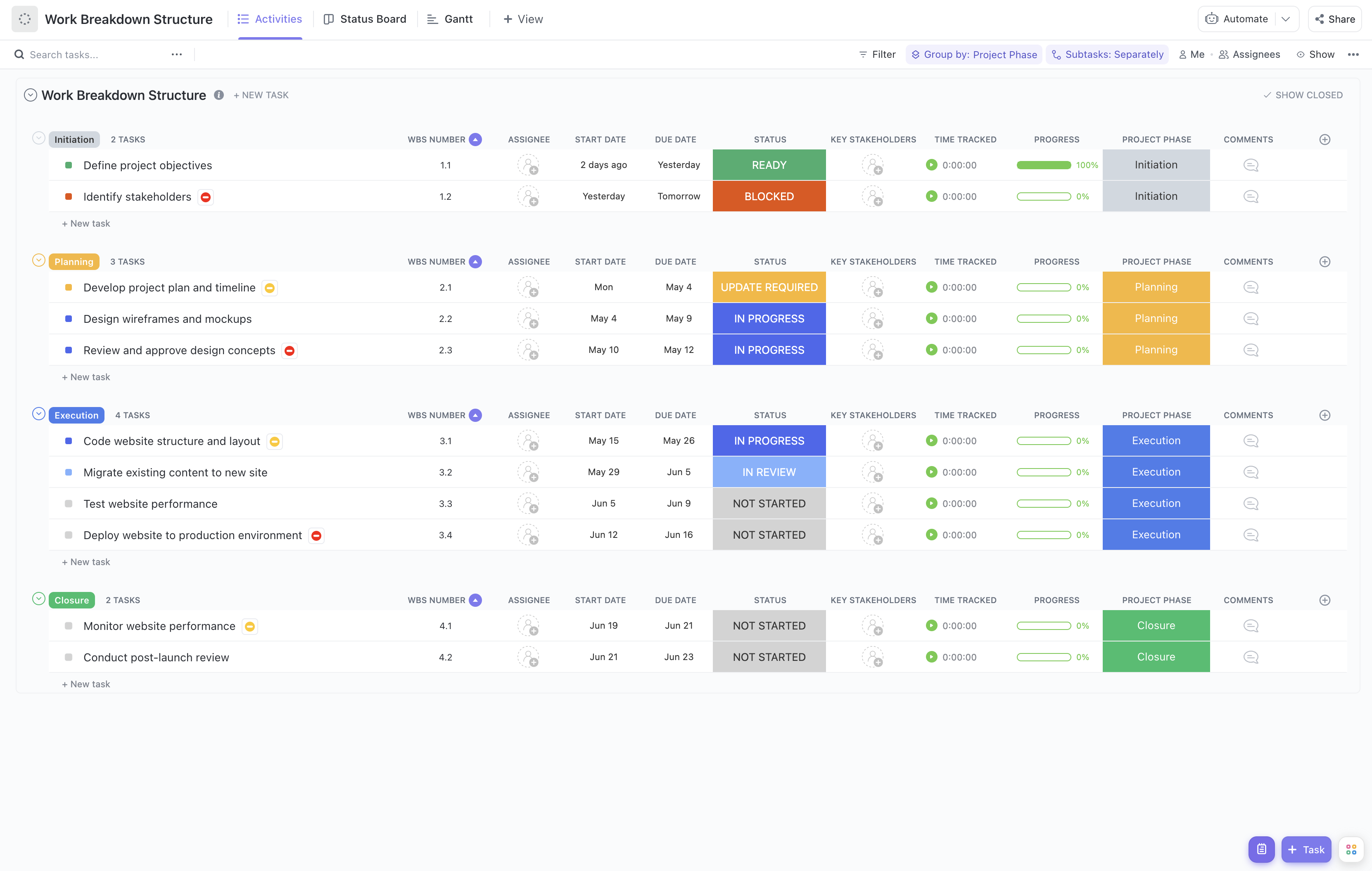When it comes to managing hardware projects, a comprehensive work breakdown structure (WBS) is essential. It's the blueprint that ensures every task, from sourcing components to final assembly, is accounted for and executed flawlessly. Fortunately, ClickUp's Hardware Work Breakdown Structure Template is here to make your life easier!
With ClickUp's WBS template, you can:
- Break down your hardware project into manageable tasks and subtasks
- Assign responsibilities to team members and track progress in real-time
- Visualize project timelines and dependencies for better planning
- Collaborate seamlessly with your team and stakeholders
Whether you're developing cutting-edge technology or building the next generation of gadgets, ClickUp's Hardware WBS Template has everything you need to bring your hardware project to life. Get started today and take your hardware projects to new heights!
Benefits of Hardware Work Breakdown Structure Template
When it comes to managing hardware projects, having a clear and organized plan is crucial. The Hardware Work Breakdown Structure (WBS) template can help you achieve just that by:
- Breaking down complex hardware projects into manageable tasks, ensuring nothing falls through the cracks
- Providing a visual representation of the project's scope and timeline, making it easier to communicate with stakeholders
- Facilitating resource allocation and budgeting by identifying the specific hardware components and materials needed
- Streamlining project execution by assigning tasks to team members and tracking progress in real-time
- Improving overall project efficiency and reducing the risk of delays or errors.
Main Elements of Hardware Work Breakdown Structure Template
ClickUp's Hardware Work Breakdown Structure template is designed to help you efficiently manage your hardware projects. Here are the main elements of this List template:
- Custom Statuses: Track the progress of your hardware tasks with 6 different statuses, including Open, Cancelled, Complete, Delayed, In Progress, and Needs Input.
- Custom Fields: Utilize 9 custom fields such as Project Phase, Allocated Budget, Consulted, Progress, Remaining Effort Hours, Responsible, Accountable, Cost Type, and Informed to capture specific information about each task and ensure accurate project tracking.
- Custom Views: Access 5 different views to gain different perspectives on your hardware projects. These include Activities, Status, Gantt, Getting Started Guide, and Timeline, allowing you to visualize your project timeline, track progress, and plan effectively.
With ClickUp's Hardware Work Breakdown Structure template, you can streamline your hardware project management and ensure successful execution.
How to Use Work Breakdown Structure for Hardware
If you're managing a hardware project, using a Hardware Work Breakdown Structure (WBS) template can help you stay organized and ensure that all tasks are accounted for. Follow these steps to effectively utilize the Hardware WBS Template in ClickUp:
1. Define the project scope and objectives
Before diving into the details, it's essential to clearly define the scope and objectives of your hardware project. Determine what needs to be accomplished and the specific deliverables you're aiming for. This will provide a clear direction for creating your WBS.
Use the Goals feature in ClickUp to define and track the project scope and objectives.
2. Break down the project into major components
Identify the major components or work packages that make up your hardware project. These components should be distinct and manageable tasks that contribute to the overall project.
Use the Board view in ClickUp to create columns for each major component and add tasks within each column to represent the work packages.
3. Further break down the work packages
Once you have identified the major components, it's time to break down each work package into smaller, more manageable tasks. These tasks should be specific and actionable, allowing you to track progress and assign responsibilities effectively.
Use subtasks in ClickUp to further break down each work package into smaller tasks. This will provide a clear hierarchy and allow for better task management.
4. Assign responsibilities and set deadlines
To ensure accountability and timely completion of tasks, assign responsibilities to team members for each task within the Hardware WBS. Clearly communicate expectations and deadlines to avoid any confusion or delays.
Use the Calendar view in ClickUp to assign due dates and track task deadlines. This will help you visualize the project timeline and ensure that tasks are completed on time.
By following these steps and utilizing the Hardware WBS Template in ClickUp, you can effectively manage your hardware project, ensure all tasks are accounted for, and keep your team organized and on track.

Get Started with ClickUp's Hardware Work Breakdown Structure Template
Project managers and hardware teams can use this Hardware Work Breakdown Structure Template to help streamline the process of building and implementing hardware systems.
First, hit “Get Free Solution“ to sign up for ClickUp and add the template to your Workspace. Make sure you designate which Space or location in your Workspace you’d like this template applied.
Next, invite relevant members or guests to your Workspace to start collaborating.
Now you can take advantage of the full potential of this template to manage hardware projects:
- Use the Activities View to break down the project into specific tasks and activities
- The Status View will help you track the progress of each task and identify any bottlenecks
- Utilize the Gantt View to create a visual timeline of the project and ensure deadlines are met
- Refer to the Getting Started Guide View to get acquainted with the template and its features
- The Timeline View will provide an overview of the project timeline and milestones
- Organize tasks into six different statuses: Open, Cancelled, Complete, Delayed, In Progress, Needs Input, to track the progress of each task
- Update statuses as tasks progress to keep team members informed
- Monitor and analyze tasks to ensure maximum productivity and project success.









